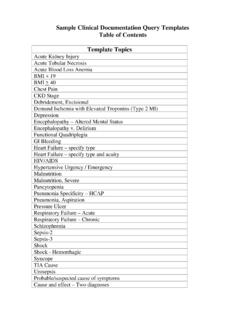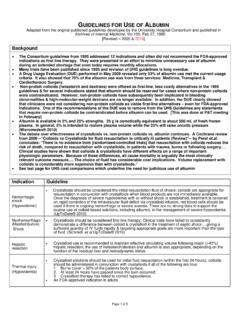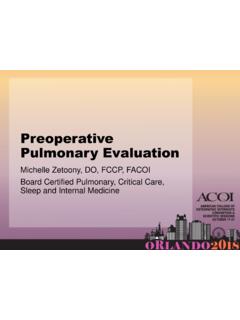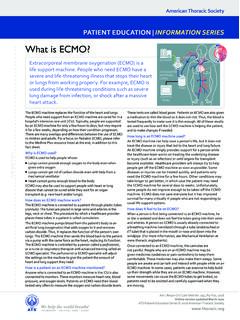Transcription of P/F Ratio Calculations Supplement to CDI Pocket Guide
1 P/F Ratio Calculations Supplement to CDI Pocket Guide The P/F Ratio is a powerful objective tool to identify acute hypoxemic respiratory failure at any time while the patient is receiving supplemental oxygen, a frequent problem faced by documentation specialists where no room air ABG is available or pulse ox readings seem equivocal. The P/F Ratio equals the arterial pO2 ( P ) from the ABG divided by the FIO2 ( F ) the fraction (percent) of inspired oxygen that the patient is receiving expressed as a decimal (40% oxygen = FIO 2 of ). A P/F Ratio less than 300 indicates acute respiratory failure. Many physicians are unfamiliar with the P/F Ratio , but it has been validated and used in the context of ards .
2 For many years, where acute respiratory failure is called acute lung injury . A P/F Ratio < 300 indicates mild ards , < 200 is consistent with moderate ards and < 100 is severe ards . The P/F Ratio indicates what the pO2 would be on room air: P/F Ratio < 300 is equivalent to a pO2 < 60 mm Hg on room air P/F Ratio < 250 is equivalent to a pO2 < 50 mm Hg on room air P/F Ratio < 200 is equivalent to a pO2 < 40 mm Hg on room air Example: Suppose the pO2 is 90mmHg on 40% oxygen (FIO2 = .40). The P/F Ratio = 90 divided by .40 = 225. The pO2 on room air in this case would have been about 45 mmHg (well below the cut-off of 60mmHg). The P/F Ratio should not be used to diagnose acute -on-chronic respiratory failure since many patients with chronic respiratory failure already have a P/F Ratio <300 (pO2 <60 mmHG) in their baseline stable state.
3 That's the reason they are treated with chronic supplemental home oxygen. SpO2 translated to PO2. The arterial pO2 measured by arterial blood gas (ABG) is the definitive method for calculating the P/F Ratio . However, when the pO2 is unknown because an ABG is not available, the SpO2 measured by pulse oximetry can be used to approximate the pO2, as shown in the Table below. It is important to note that estimating the pO2. from the SpO2 becomes unreliable when the SpO2 is 98% - 100%. Conversion of SpO2 to pO2. SpO2 pO2. (percent) (mm Hg). 86 51. 87 52. 88 54. 89 56. 90` 58. 91 60. 92 64. 93 68. 94 73. 95 80. The SpO2/pO2 conversion becomes unreliable when 96 90. 97 110 SpO2 is > 98%.
4 Example: Suppose a patient on 40% oxygen has a pulse oximetry SpO2 of 95%. Referring to the Table above, SpO2 of 95% is equal to a pO2 of 80mmHg. The P/F Ratio = 80 divided by = 200. The patient may be stable receiving 40% oxygen, but still has severe acute respiratory failure. If oxygen were withdrawn leaving her on room air, the pO2 would only be 40 mmHg (much less than the cut-off for acute respiratory failure of 60. mmHg on room air). Translating Supplemental Oxygen: FIO2 (percent) and liters per minute Supplemental oxygen may be administered either by mask or by nasal cannula ( NC ). A Venturi mask (Venti-mask) delivers a controlled flow of oxygen at a specific fixed concentration (FIO2): 24%, 28%, 31%, 35%, 40%, and 50%.
5 The non-rebreather ( NRB ) mask is designed to deliver approximately 100% oxygen. Providing 40% or more supplemental oxygen implies that the physician is treating acute respiratory failure since only a patient with acute respiratory failure would need that much oxygen. A nasal cannula provides oxygen at adjustable flow rates in liters of oxygen per minute (L/min or LPM ). The actual FIO2 (percent oxygen) delivered by nasal cannula is somewhat variable and less reliable than with a mask, but can be estimated as shown in the Table below. The FIO2 derived from nasal cannula flow rates can then be used to calculate the P/F Ratio . Flow Assumes room air is Rate FIO2 20% and each L/min of 1 L/min 24% oxygen = +4%.
6 2 L/min 28%. 3 L/min 32%. 4 L/min 36%. 5 L/min 40%. 6 L/min 44%. Example: A patient has a pO2 of 85mmHg on ABG while receiving 5 L/min of oxygen. Since 5 L/min is equal to 40% oxygen (an FIO2 of ), the P/F Ratio = 85 divided by =





